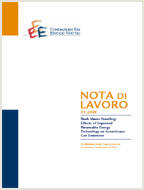Afforestation and Timber Management Compliance Strategies in Climate Policy. A Computable General Equilibrium Analysis

04.01.2011
Melania Michetti, Renato Nunes Rosa
D58, Q23, Q24, Q52, Q54
Climate Change, General Equilibrium Modelling, Forestry, Afforestation
Climate Change and Sustainable Development
Carlo Carraro
This paper analyzes the role of afforestation-reforestation and timber management activities, and their major and secondary economic effects in stabilizing climate during the first commitment period of the Kyoto Protocol. In particular, with a Computable General Equilibrium framework, the ICES model, it is inferred how forest carbon sequestration fits within the European domestic portfolio of a 2020-20 and 2020-30 climate stabilization policy. Afforestation and land use are accounted for by introducing their effects in the model. This is done by relying on carbon sequestration curves provided by Sohngen (2005), which describe the average annual cost of sequestration for selected world regions. Results show that afforestation and timber management could lead to substantially lower policy costs if included. By allowing afforestation alone it is possible to achieve the 30% emissions reduction target with an additional European effort of only 0.2% compared with the cost of a 20% emissions reduction without afforestation. The introduction of these alternatives for mitigating climate is expected to reduce carbon price by around 30% in 2020 and the already contained leakage effect (around 1%), coming from an independent European commitment, by 0.2%.
***
Suggested citation: Melania Michetti, Renato Rosa, Afforestation and timber management compliance strategies in climate policy. A computable general equilibrium analysis, Ecological Economics, Volume 77, May 2012, Pages 139-148, ISSN 0921-8009, http://dx.doi.org/10.1016/j.ecolecon.2012.02.020
